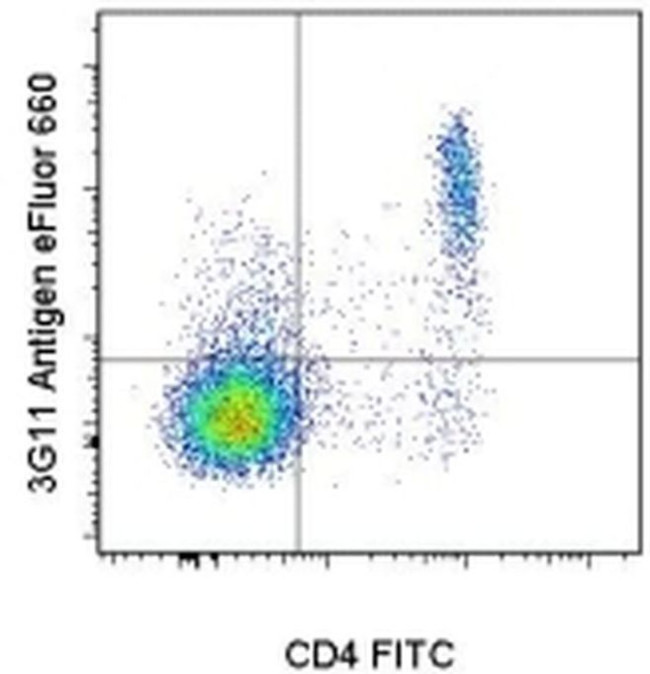Search Thermo Fisher Scientific
Invitrogen
3G11 Sialoganglioside Antigen Monoclonal Antibody (eBio3G11 (SM3G11, 3G11)), eFluor™ 660, eBioscience™
Product Details
50-5443-82
Species Reactivity
Host/Isotype
Recommended Isotype Control
Class
Type
Clone
Conjugate
Excitation/Emission Max
Form
Concentration
Purification
Storage buffer
Contains
Storage conditions
Shipping conditions
RRID
Product Specific Information
Description: The eBio3G11 monoclonal antibody reacts with the mouse 3G11antigen. The 3G11 antibody was isolated as an autoantibody against the 3G11 sialylated carbohydrate antigen, which was found to be expressed by thymoyctes and peripheral T cells, but not by B cells, myeloid cells or erythrocytes. 3G11 is expressed at higher levels on CD4+ T cells than on CD8+ T cells, however expression on both of these subsets decreases with advancing age. In thymus, 3G11 is expressed on approximately 20% of total thymocytes. 3G11 has also been used as a marker to distinguish naive and memory T cells, as 3G11 is irreversibly down-regulated upon activation of CD4+ T cells. The 3G11 antibody is able to block binding of antibodies to CD3 epsilon, suggesting close proximity of these two proteins.
Recently, it has been demonstrated that loss of 3G11 expression in experimental autoimmune encephalomyelitis (EAE) is associated with an anergic, regulatory T phenotype. Purified 3G11- T cells were able to suppress proliferation and cytokine production of 3G11+ T cells, and part of this effect was due to the secretion of IL-10.
Applications Reported: This eBio3G11 (SM3G11, 3G11) antibody has been reported for use in flow cytometric analysis.
Applications Tested: This eBio3G11 (SM3G11, 3G11) antibody has been tested by flow cytometric analysis of mouse splenocytes. This can be used at less than or equal to 0.25 µg per test. A test is defined as the amount (µg) of antibody that will stain a cell sample in a final volume of 100 µL. Cell number should be determined empirically but can range from 10^5 to 10^8 cells/test. It is recommended that the antibody be carefully titrated for optimal performance in the assay of interest.
eFluor® 660 is a replacement for Alexa Fluor® 647. eFluor® 660 emits at 659 nm and is excited with the red laser (633 nm). Please make sure that your instrument is capable of detecting this fluorochome.
Excitation: 633-647 nm; Emission: 668 nm; Laser: Red Laser.
Filtration: 0.2 µm post-manufacturing filtered.
Target Information
The 3G11 sialylated carbohydrate antigen was found to be expressed by thymoyctes and peripheral T cells, but not by B cells, myeloid cells or erythrocytes. 3G11 is expressed at higher levels on CD4+ T cells than on CD8+ T cells, however expression on both of these subsets decreases with advancing age. In thymus, 3G11 is expressed on approximately 20% of total thymocytes. 3G11 has also been used as a marker to distinguish naive and memory T cells, as 3G11 is irreversibly down-regulated upon activation of CD4+ T cells. 3G11 antibodies can be used to block binding of antibodies to CD3 epsilon, suggesting close proximity of these two proteins. Recently, it has been demonstrated that loss of 3G11 expression in experimental autoimmune encephalomyelitis (EAE) is associated with an anergic, regulatory T phenotype. Purified 3G11- T cells were able to suppress proliferation and cytokine production of 3G11+ T cells, and part of this effect was due to the secretion of IL-10.
For Research Use Only. Not for use in diagnostic procedures. Not for resale without express authorization.
How to use the Panel Builder
Watch the video to learn how to use the Invitrogen Flow Cytometry Panel Builder to build your next flow cytometry panel in 5 easy steps.
References (0)
Bioinformatics
Protein Aliases: 3G11 antigen

Performance Guarantee
If an Invitrogen™ antibody doesn't perform as described on our website or datasheet,we'll replace the product at no cost to you, or provide you with a credit for a future purchase.*
Learn more
We're here to help
Get expert recommendations for common problems or connect directly with an on staff expert for technical assistance related to applications, equipment and general product use.
Contact tech support


